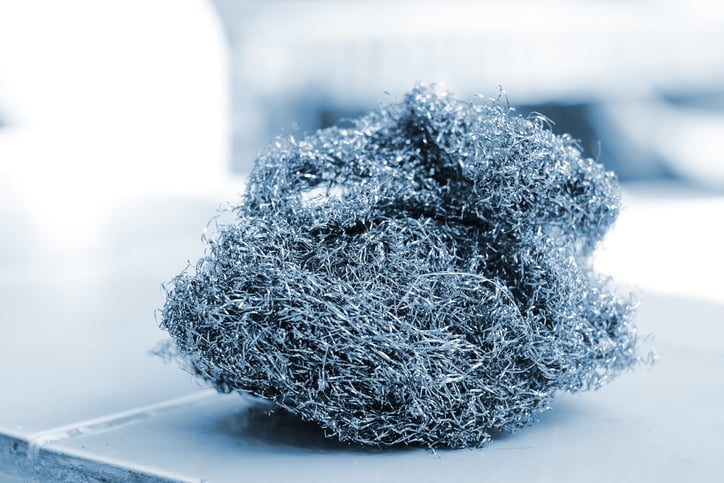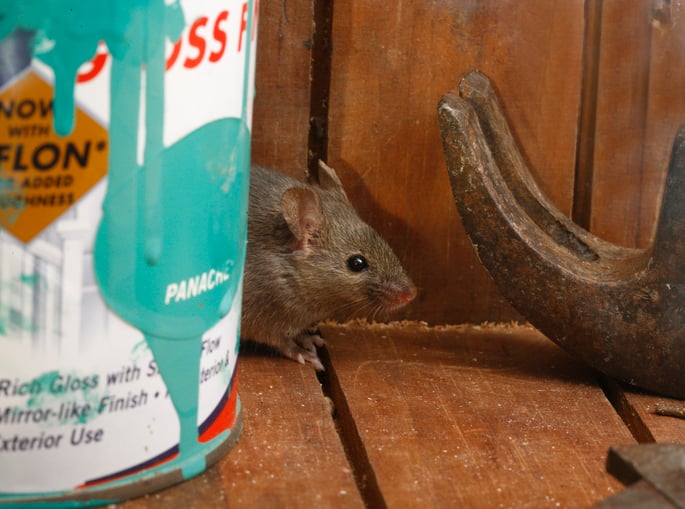Steel wool is a versatile and effective tool for controlling mice and keeping them out of your home. With its abrasive and sturdy nature, steel wool can be used to block the entry points that mice use to access your living spaces. By understanding how to properly use steel wool, you can create a barrier that deters mice and helps prevent infestations. Whether you’re dealing with an existing mouse problem or want to proactively protect your home, steel wool can be an invaluable asset in your pest control efforts.

Table of Contents
- Understanding Steel Wool In Pest Control
- Steel Wool In Mouse Control
- Implementing Steel Wool For Mouse Control
- Types, Purchase, And Disposal Of Steel Wool
- Complementary Pest Control Methods
- Safety And Precautions
- Impact And Professional Use Of Steel Wool
- Advantages Of Steel Wool For Mouse Control
- Conclusion
Understanding Steel Wool In Pest Control
Steel wool is a versatile and widely used household material that consists of thin steel filaments twisted together to form a mesh-like structure. It is primarily made from low-carbon steel, which is durable and resistant to corrosion. Steel wool comes in different grades, ranging from coarse to fine, depending on the thickness of the steel filaments.
Steel wool is an effective material for pest control, particularly for blocking entry points and preventing the intrusion of rodents and insects. Its properties make it an ideal barrier against unwanted pests. It is important to note that when using steel wool for pest control, it is crucial to use high-grade steel wool, such as the one specifically designed for rodent exclusion. Additionally, it is recommended to wear gloves while handling steel wool to avoid injury or irritation.
Rodent Exclusion
Mice and rats can squeeze through even the tiniest openings, making it essential to seal entry points to prevent their entry into homes or structures. Steel wool is an excellent choice for this purpose. It can be tightly packed into cracks, gaps, holes, and other potential entryways, creating a barrier that rodents cannot gnaw through. When combined with other sealants like caulk or foam, steel wool forms a durable and long-lasting deterrent.
Insect Prevention
Steel wool can also be used to keep insects, such as ants and spiders, from entering buildings. Filling gaps around windows, doors, pipes, and utility lines with steel wool creates a physical barrier that insects find difficult to penetrate.
Steel Wool In Mouse Control
As a popular choice among homeowners and pest control professionals, steel wool is known for its effectiveness in preventing mice from entering structures through small openings and gaps. Its unique properties make it a formidable barrier that mice struggle to chew through, making it an invaluable tool in mouse control.
Effectiveness Of Steel Wool In Controlling Mice
Steel wool is highly effective in preventing mice from gaining entry into structures. Its coarse and abrasive texture makes it challenging for mice to chew through, acting as a physical barrier. By blocking small openings, gaps, and cracks with steel wool, homeowners can significantly reduce the chances of mice entering their homes. It is particularly useful for sealing openings around pipes, vents, windows, and doors.
Can Mice Chew Through Steel Wool?
While mice have strong teeth and a natural instinct to gnaw, they find it difficult to chew through steel wool. The metal fibers of steel wool are tightly packed, making it tough and resistant to their gnawing efforts. It acts as a deterrent and makes it harder for mice to penetrate through the barrier. However, it’s important to ensure that the steel wool is tightly packed and securely placed to prevent any gaps or loose ends that mice could exploit.
Comparison Of Steel Wool To Other Mouse Deterrent Methods
Steel wool is often preferred over other mouse deterrent methods for several reasons. Unlike chemical repellents, traps, or poisons, steel wool is a non-toxic and environmentally friendly option. It does not pose any risks to children, pets, or the environment. Additionally, steel wool is a long-lasting material that can withstand weathering and degradation better than alternatives like foam or caulk, ensuring a more durable barrier against mice.
Long-Term Solution For Mice Infestation
While steel wool is effective in the short term, it may not be a complete long-term solution for a significant mice infestation. Steel wool primarily acts as a preventive measure, sealing entry points to prevent mice from entering the structure. However, it does not address existing mice within the building. To address a mice infestation comprehensively, it is important to combine steel wool with other control methods, such as traps, baits, or professional extermination services. These measures are necessary to eliminate existing mice and prevent future infestations.
Implementing Steel Wool For Mouse Control
To effectively use steel wool for mouse control, it is important to identify and seal potential entry points where mice can gain access to your home. Inspect the exterior of your house, paying close attention to areas such as gaps around pipes, vents, utility lines, and foundation cracks. These are common entry points that mice can exploit. Once identified, thoroughly clean and dry the area before proceeding.
Can Mice Move Steel Wool?
While steel wool is an effective deterrent, it is not entirely foolproof. Mice have been known to move or displace steel wool if they are determined to gain entry. Therefore, it is crucial to regularly inspect and monitor the areas where steel wool has been placed to ensure its effectiveness. If you notice any signs of disturbance, it is recommended to reinforce or replace the steel wool.
Tips On How To Secure Steel Wool In Mouse Entry Points
When securing steel wool in mouse entry points, there are several tips to keep in mind to ensure its effectiveness.
Size And Shape
Cut the steel wool into pieces that are large enough to tightly fit into the gaps or openings but small enough to be easily packed. Ensure the steel wool completely fills the space, leaving no gaps or openings for mice to squeeze through.
Pack Tightly
It is crucial to pack the steel wool tightly into the entry point. Use a screwdriver or any other suitable tool to push the steel wool deep into the gap. The tighter the steel wool is packed, the more challenging it will be for mice to dislodge or move it.
Layering
For larger openings or gaps, consider layering the steel wool. Place a layer of steel wool, followed by a layer of caulk or expandable foam, and then another layer of steel wool. This creates a more robust barrier that is harder for mice to penetrate.
Secure With Additional Materials
To further secure the steel wool in place, consider using other materials such as caulk, adhesive, or wire mesh. Apply these materials around the edges of the steel wool to provide additional reinforcement and prevent mice from pushing it aside.
Regular Inspection And Maintenance
Periodically inspect the areas where steel wool has been placed to ensure its effectiveness. Look for any signs of disturbance, such as displaced steel wool or new gaps that mice may have created. If necessary, reinforce or replace the steel wool to maintain a strong barrier against mice.
Monitor Potential Entry Points
In addition to securing known entry points, keep an eye out for new or potential entry points that mice may exploit. Regularly check areas such as crawl spaces, attics, and basement windows for any signs of mouse activity or openings that need to be sealed.
Common Mistakes When Using Steel Wool For Mouse Control
One common mistake is using low-grade steel wool that mice can easily chew through. Ensure you use high-quality, thick, and dense steel wool that offers maximum resistance. Another mistake is not properly sealing the gaps or openings before placing the steel wool. Mice can find alternative routes if there are other accessible entry points nearby.
How To Use Steel Wool For Both Indoor And Outdoor Mouse Control
Steel wool can be used both indoors and outdoors to deter mice. For indoor use, focus on areas such as gaps around baseboards, windows, doors, and utility lines. In outdoor spaces, pay attention to openings near the foundation, vents, and pipes. Always remember to seal the entry points properly before applying steel wool.
Types, Purchase, And Disposal Of Steel Wool
When it comes to pest control, steel wool is a versatile and effective material that can be used for various purposes, including blocking entry points for mice and other rodents. In this section, we will explore the different types and grades of steel wool that are best suited for controlling mice, as well as provide guidance on where to purchase it.
Specific Types Or Grades Of Steel Wool Best For Controlling Mice
When it comes to controlling mice, specific types or grades of steel wool are highly effective in preventing their entry. Fine or extra fine-grade steel wool is considered the best choice for mouse control. These types of steel wool have thinner strands and denser fibers, making it more challenging for mice to chew through or push aside. The fine strands of steel create a formidable physical barrier that mice find difficult to penetrate. By selecting fine or extra fine-grade steel wool, you can ensure that it provides a reliable deterrent against mice seeking entry through small gaps, cracks, or holes in your home. It is important to choose steel wool that is made of 100% steel without any added coatings, oils, or soaps, as these additives may reduce its effectiveness.
Where To Purchase Steel Wool For Mouse Control
Steel wool, an effective material for mouse control, can be purchased from various sources at different price points. Local hardware stores offer steel wool in different grades and sizes, with prices typically ranging from $2 to $10 per pack, depending on the quantity and quality. Home improvement centers may have a wider selection, including premium brands, with prices ranging from $5 to $15 per pack. Online retailers such as Amazon and hardware specialty websites offer competitive prices, with packs of steel wool ranging from $3 to $12, depending on the brand and quantity. It’s important to compare prices and read customer reviews to ensure you’re getting the best value for your money. Additionally, keep in mind that bulk purchases or multipacks may offer cost savings in the long run.
How To Dispose Of Used Steel Wool For Mouse Control
Since steel wool can be a fire hazard if not handled correctly, it should not be thrown into regular trash bins. Instead, the best way to dispose of used steel wool is to seal it in a metal or sturdy plastic container to prevent any potential fire risk. You can then take it to your local recycling center or contact your municipality for specific instructions on disposing of metal waste. Some recycling centers may accept steel wool along with other metal items for recycling. It’s important to check with your local waste management facility to determine the proper method of disposal in your area. By following these guidelines, you can ensure that used steel wool is disposed of safely and in an environmentally responsible manner.
Complementary Pest Control Methods
By combining different approaches to mouse control, such as using steel wool alongside other strategies, you can create a comprehensive and effective plan to combat infestations.
The Benefit Of Using Steel Wool In Combination With Other Pest Control Methods
Steel wool is a versatile tool that can be used in conjunction with other pest control methods to enhance effectiveness. When combined with techniques like sealing entry points and maintaining cleanliness, steel wool acts as an additional barrier that helps prevent pests, including mice, from gaining access to your home. By using multiple approaches, you create a comprehensive defense system against pests and increase the chances of successful pest control.
Other Pests That Can Be Controlled With Steel Wool
While steel wool is commonly used for mouse control, it can also be effective against other pests. Rats, for example, have similar chewing habits to mice and can be deterred by steel wool placed in their entry points. Additionally, steel wool can be used to block the access points of larger pests like squirrels or raccoons. By preventing these pests from entering your home or property, you reduce the risk of damage, contamination, and potential health hazards associated with their presence.
Alternatives To Steel Wool For Controlling Mice
Although steel wool is a popular choice for mouse control, there are alternative methods available. Some people opt for using wire mesh or copper mesh as alternatives to steel wool. These materials provide similar physical barriers to prevent mice from entering small openings. Additionally, there are electronic devices available, such as ultrasonic repellents, which emit high-frequency sounds that are unpleasant for mice and can help deter them. It’s important to explore different options and choose the method that best suits your needs and preferences when it comes to controlling mice in your specific situation.
Safety And Precautions
When using steel wool for various purposes, including pest control, it is important to prioritize safety and take necessary precautions. Steel wool can be an effective tool, but it also poses potential risks if mishandled or used improperly.
The Potential Harm Of Steel Wool To Pets Or Small Children
Steel wool is made of fine, abrasive fibers that can cause injury if ingested or if its sharp edges are mishandled. Pets or small children may be curious and attempt to play with or chew on the steel wool, which can lead to internal injuries or choking hazards. It is crucial to keep steel wool out of reach of children and pets, storing it in a secure place where they cannot access it. Additionally, always closely supervise children and pets when using steel wool or any pest control materials to prevent accidents or injuries.
Precautions To Take When Handling And Applying Steel Wool For Pest Control
When handling and applying steel wool for pest control, it is important to take certain precautions to ensure safety. First, it is advisable to wear protective gloves to prevent any irritation or cuts from the sharp edges of the steel wool. Additionally, consider wearing eye protection to shield your eyes from any loose fibers that may become airborne during handling. When applying steel wool, make sure to use it in areas where it will not come into contact with moisture or water, as this can cause rusting. It is also crucial to be mindful of potential fire hazards, as steel wool is highly flammable. Avoid using steel wool near open flames or heat sources, and ensure it is properly extinguished and disposed of after use. Finally, remember to follow the manufacturer’s instructions and recommendations for the safe usage and disposal of steel wool. By taking these precautions, you can minimize the risks associated with handling and applying steel wool for pest control purposes.
Impact And Professional Use Of Steel Wool
Environmental Impact
The impact of using steel wool for mouse control on the environment is generally considered to be minimal. Steel wool itself is made of steel fibers, which is a natural and non-toxic material. When properly used and disposed of, steel wool poses little risk to the environment. However, it is important to note that the effectiveness of steel wool in mouse control lies in its ability to block entry points and prevent mice from entering certain areas. This means that in some cases, steel wool may be placed in locations where it is exposed to weathering or outdoor elements. In such situations, it is important to monitor the steel wool and replace it if it becomes worn or deteriorated to prevent any potential environmental impact. Additionally, proper disposal of used steel wool is essential to prevent it from entering water sources or becoming litter.
Professional Use
Professional pest control services may use steel wool as part of their methods for mouse control, especially when it comes to sealing entry points and preventing mice from accessing a property. Steel wool’s ability to effectively block small openings makes it a valuable tool in pest management. However, it is important to note that the specific techniques and materials used by professional pest control services may vary depending on the situation and the company’s practices. Some professionals may choose to use alternative materials or methods for sealing entry points, depending on the specific needs of the infestation and the structure being treated. It is advisable to consult with a professional pest control service to determine the most appropriate and effective methods for addressing a mouse problem in a specific situation.
Advantages Of Steel Wool For Mouse Control
Steel wool is a versatile and effective tool for mouse control, offering several advantages in combating mouse infestations. In this section, we will explore the numerous advantages of using steel wool for mouse control, including its efficacy, affordability, and eco-friendliness.
Benefits Of Using Steel Wool For Mouse Control
There are several benefits to using steel wool for mouse control. First and foremost, steel wool is an effective deterrent that can create a physical barrier against mice. Its dense and abrasive nature makes it difficult for mice to chew through or squeeze past, effectively sealing off potential entry points. Steel wool is also a versatile solution, as it can be easily cut and shaped to fit different openings, such as gaps in walls, floors, pipes, and vents. Additionally, steel wool is a durable material that can withstand environmental conditions, providing long-lasting protection against mice.
Another advantage is that steel wool is a chemical-free method, making it a safe and environmentally friendly option for mouse control. By using steel wool, homeowners can effectively prevent mice from accessing their property without the need for harmful chemicals or toxins.
Ethics Of Using Steel Wool
The use of steel wool for mouse control raises ethical considerations that are important to address. While steel wool is an effective deterrent, it is essential to ensure that its use is humane. Steel wool creates a physical barrier that prevents mice from accessing certain areas, but it does not harm them directly. However, it is crucial to consider the potential impact on mice if they are already inside the property. In such cases, trapping and removal methods should be implemented alongside the use of steel wool to ensure that mice are not trapped or left in inaccessible areas, leading to suffering or starvation.
How Long Steel Wool Lasts When Used For Mouse Control
The duration of effectiveness for steel wool when used for mouse control can vary based on several factors. On average, steel wool barriers can provide effective protection against mice for several months to a year. However, the actual lifespan depends on variables such as the severity of the mouse infestation, the location of the steel wool barriers, and the behavior of the mice.
High-traffic areas or places with active mouse activity may experience faster wear and tear of the steel wool. It is advisable to inspect the barriers every 3-6 months and replace any damaged sections promptly. Environmental conditions, such as humidity and exposure to moisture, can also impact the durability of steel wool. Regular maintenance and monitoring are crucial to ensuring the ongoing effectiveness of steel wool as a mouse deterrent. While steel wool provides a long-lasting solution, it should be supplemented with other preventive measures to ensure comprehensive and lasting mouse control.
Conclusion
In conclusion, steel wool is a valuable tool for controlling mice and preventing their entry into homes and buildings. Its versatility, durability, and affordability make it a popular choice for DIY pest control. By identifying and sealing potential entry points with steel wool, you can effectively block the access of mice and minimize the risk of infestation. Remember to take necessary safety precautions when handling and installing steel wool, and always consider the ethical and humane aspects of pest control. By combining steel wool with other complementary methods and practicing good hygiene and cleanliness, you can create an inhospitable environment for mice and protect your living spaces from these unwanted pests.




